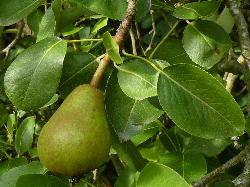- Taxon
- Gallery
Medium-sized to tall tree with rough shallowly fissured, dark grey bark, c. 6–12 m high (to c. 15 m in cultivation); branches erect when young but later spreading. Young shoots shining brown or reddish brown, becoming glabrous, sometimes with branch spines on older shoots. Lvs very variable and mostly crowded on short shoots; petiole 15–65–(80) mm long; glabrate to pilose; blade broadly ovate, elliptic, broad-elliptic, or suborbicular, (25)–35–80–(100) × (20)–30–60–(80) mm, apiculate to acuminate, rounded at base, bright green, glossy and glabrous above when mature, paler below and sometimes pilose when young, crenulate-serrate; stipules attenuate. Infl. of usually 5–10 fls; pedicels 18–30 mm long, glabrate or softly pilose. Sepals triangular, brown- or grey-tomentose, recurved. Petals broadly obovate or obovate-oblong, 14–22 × 10–18 mm, concave, white; apex rounded. Anthers ± purple. Fr. usually pyriform or broadly obovoid, less commonly subglobose or globose, usually 40–80 mm long (longer in some cultivated plants), sweet, with a gritty texture when ripe; skin green to yellow, sometimes brown.
[From: Webb et al. (1988) Flora of New Zealand. Volume 4.]
Flowering: Sep.–Oct.




